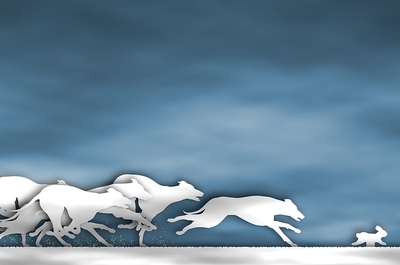 It is no exaggeration to suggest that millions of people around the globe enjoy watching things move quickly. No matter if it is cars, bikes, horses or dogs, lots of people enjoy the thrill of seeing some kind of mechanical technology, animals or humans going as fast as they possibly can. Add the chance to win some money into the equation and it is little wonder why greyhound racing was, and still is to a lesser extent, a very popular sport.
It is no exaggeration to suggest that millions of people around the globe enjoy watching things move quickly. No matter if it is cars, bikes, horses or dogs, lots of people enjoy the thrill of seeing some kind of mechanical technology, animals or humans going as fast as they possibly can. Add the chance to win some money into the equation and it is little wonder why greyhound racing was, and still is to a lesser extent, a very popular sport.
Although we are well accustomed to racing greyhounds in the United Kingdom and Ireland, it is worth exploring the question of why it is greyhounds specifically that are used for racing. Even a walk around your local park will tell you that they are not the only rapid dog breed. It is not all just a matter of speed though as you will soon find out. Greyhounds are simply one of the best breeds of dogs to race for several other reasons aside from their blistering pace.
Prey Drive
 Prey drive is such a crucial reason as to why we race greyhounds rather than some other quick dog breeds.
Prey drive is such a crucial reason as to why we race greyhounds rather than some other quick dog breeds.
Greyhounds are classed as sighthounds, or gazehounds, which means they hunt purely by sight and speed rather than relying on a great sense of smell or endurance. When able to run at such speeds, there is simply no need to have any other highly developed senses or skills when it comes to hunting down prey.
This means greyhounds do have an innate desire to ‘chase’ things and this is what we mean by prey drive. In the case of greyhound racing, a mechanical hare is used as the item to be chased. Greyhounds will duly attempt to run down this hare, in vain, every time they are released from the traps.
It is simply in their nature to instinctively chase down such a creature and they will do so time and time again, virtually without fail.
Vision
 As you may well have noticed, some dogs have flat faces (brachycephalic breeds) and others have noticeably longer skulls (dolichocephalic breeds). Greyhounds fall into this latter category and it makes a difference for racing purposes.
As you may well have noticed, some dogs have flat faces (brachycephalic breeds) and others have noticeably longer skulls (dolichocephalic breeds). Greyhounds fall into this latter category and it makes a difference for racing purposes.
Why?
Because dolichocephalic breeds have a much wider field of vision, on average about 270 degrees, and this enables them to keep tabs on their surroundings much better.
Greyhounds also have stereoscopic vision which aids them when tracking moving objects. This means they have absolutely no problem tracking the hare that zips around the permitter of the course.
Low Maintenance
 Many dog breeds require a lot of exercise to stay fit and healthy so be prepared to take them out for plenty of walks. Contrary to what you might think for such an athletic dog though, greyhounds are not energetic creatures and 45 to 60 minutes of exercise daily will be more than sufficient for most. This does need to include a few sprints mind you, as greyhounds do like to stretch their legs and get their heartbeat up when outside.
Many dog breeds require a lot of exercise to stay fit and healthy so be prepared to take them out for plenty of walks. Contrary to what you might think for such an athletic dog though, greyhounds are not energetic creatures and 45 to 60 minutes of exercise daily will be more than sufficient for most. This does need to include a few sprints mind you, as greyhounds do like to stretch their legs and get their heartbeat up when outside.
In addition to this, greyhounds are extremely healthy dogs overall. Their deep chest does mean they are more susceptible to bloating and gastric torsions but no dog is without its specific problems. There are few other issues greyhounds are particularly prone to picking up though, and as such, they are widely believed to be one of the healthiest breeds. This helps keeps vet bills down which is important given that prize money in dog racing is hardly sky-high.
Being relatively cheap to run makes greyhounds a much more viable option to race than breeds that are regularly struck down by expensive medical issues or that which require hours of daily exercise.
Lack of Aggression
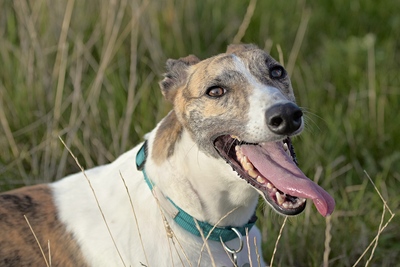 Greyhounds have an abundance of predatory aggression and this describes the desire to chase down and grab moving prey. If the greyhounds could manage to catch up to the hare (and it was a real hare) then they would give it a bite and try to shake it. Predatory aggression is adrenalin-fuelled and offers a release of dopamine, so there is an internal motivation to chase things down.
Greyhounds have an abundance of predatory aggression and this describes the desire to chase down and grab moving prey. If the greyhounds could manage to catch up to the hare (and it was a real hare) then they would give it a bite and try to shake it. Predatory aggression is adrenalin-fuelled and offers a release of dopamine, so there is an internal motivation to chase things down.
Predatory aggression however should not be confused with inter-dog aggression, this being aggression shown to other dogs. The aggression we see while the greyhounds are running does not extend to a general aggressive attitude. An average well-trained greyhound will not show any aggression to its fellow competitors, people at the racecourse or its handlers during training.
They are however somewhat prone to getting over-excited due to racing because of the adrenaline rush and this can potentially lead to them biting other dogs. Inexperienced racing dogs could also potentially bite out of anxiety. This is part of the reason why greyhounds race wearing muzzles. Another reason, however, is that the muzzle offers some protection to the mouth/nose, which is important when travelling at such speeds.
The Speed
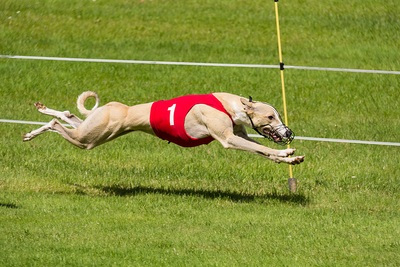 Although all the above factors play their part, there is no denying that greyhounds have become the dog racing breed of choice due to their pace. Able to hit speeds as high as 45mph, it is widely accepted that greyhounds are the fastest dogs on the planet.
Although all the above factors play their part, there is no denying that greyhounds have become the dog racing breed of choice due to their pace. Able to hit speeds as high as 45mph, it is widely accepted that greyhounds are the fastest dogs on the planet.
What is equally as impressive is that they only require six strides from a standing start before hitting their top speed. This combination of blistering acceleration, lightning-quick top speed and the agility to smoothly manoeuvre around bends means greyhounds provide maximum canine entertainment.
It is worth mentioning at this stage that part of the reason why greyhounds can run so fast and with so much athleticism is due to their extremely large hearts. Their hearts are so large in fact that they are close to the size of a human heart, despite weighing roughly half as much. This allows greyhounds to pump a huge amount of blood around the body with each beat, providing more oxygen for their muscles.
Cultural Differences
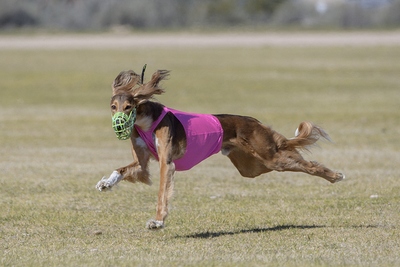 Just because greyhounds are raced in Britain and Ireland does not mean that this is the dog of choice across the world. Reaching top speeds of around 42mph, salukis is a breed only marginally slower than greyhounds. For what they just lack in speed, however, they make up for in stamina. Greyhounds can only maintain their sprint for around 250 metres but a saluki can go a fair way further than this at top speed.
Just because greyhounds are raced in Britain and Ireland does not mean that this is the dog of choice across the world. Reaching top speeds of around 42mph, salukis is a breed only marginally slower than greyhounds. For what they just lack in speed, however, they make up for in stamina. Greyhounds can only maintain their sprint for around 250 metres but a saluki can go a fair way further than this at top speed.
Salukis are one of the oldest dog breeds still around today and they were once considered to have originated from heaven, according to Arabian legends. Their prominence in Middle Eastern culture sees the saluki sometimes referred to as the royal dog of Egypt. It was their ability to hunt that made them such a prized asset dating back to ancient times.
Being bred for hunting means salukis have a strong prey drive and this, combined with their speed, means they have a lot of racing potential. It is no great surprise then that they are the dog of choice when it comes to racing in the Middle East, where they are far more prominent. Rather than seeing greyhounds in the region, you will see salukis competing in action as they dart across the dirt courses. There is an annual Saluki Championship in which hundreds of hopefuls attempt to be crowned champions in races that offers as much as $40,000 in prize money.
As an interesting side note, you will not find a robotic hare zipping around the course at these championships. The 2020 edition of the championships introduced a robotic gazelle that looked incredibly like the real thing thanks to having a genuine hide.
Other Alternatives
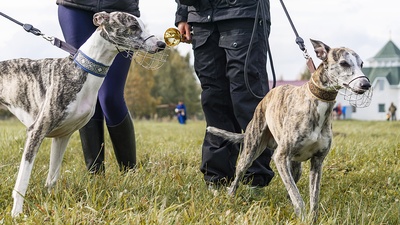 It is partly down to geography, therefore, why greyhounds, rather than salukis are the dominate choice for British and Irish racing as both are extremely good options. But are there any other dogs with racing potential though that could have taken the greyhounds’ spotlight had things panned out different?
It is partly down to geography, therefore, why greyhounds, rather than salukis are the dominate choice for British and Irish racing as both are extremely good options. But are there any other dogs with racing potential though that could have taken the greyhounds’ spotlight had things panned out different?
Whippets are one breed to be considered, especially as they began to be bred for racing in the mid-nineteenth century. Back in those days, whippet racing took the form of ‘ragging’ in which dogs were kept on a leash before being let off simultaneously.
At the end of the track, the dogs’ owners would be there, waving a rag or towel to encourage them to run. Although popularity in whippet racing eventually declined, perhaps due to their significantly lower top speed of 35 mph, it is still alive and kicking in an extremely limited capacity.
Vislaz would also potentially make good racing dogs as they tick many of the boxes required for a sporting breed. As easily trained natural hunters that are able to run as fast as 40 miles an hour, they boast both the drive and speed. It is perfectly possible that in another situation, vislaz dogs would be the go-to animal but it is a Hungarian breed that was only first introduced to the UK in the 1950s. By this point, greyhound racing was at the peak of its popularity and no breed was realistically going to replace it. By contrast, dog racing has never really been popular in Eastern Europe so the vislaz never had the opportunity to show off their pedigree as competitive racers.
